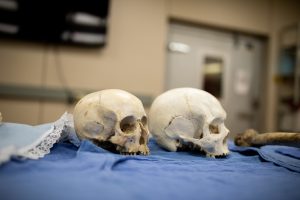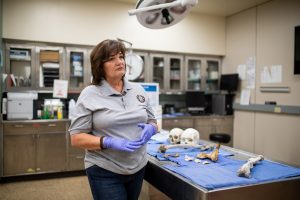- Slug: BC-CNS-Missing in Arizona. 405 words.
- Photos and captions below.
- Video here.
By HOLLY BERNSTEIN
Cronkite News
PHOENIX – It’s grim, heartbreaking and hopeful work.
Every year, families of missing people bring medical records, photos, fingerprints and maybe DNA samples to a team of forensic scientists who try to match them with jawbones and other skeletal remains, police sketches and dental records that put flesh on bones.
Forensic experts and law-enforcement officials collect information from loved ones at the annual Missing in Arizona Day. This year’s event is Saturday in west Phoenix. Officials – surrounded by tables topped with jawbones, skulls and other bone fragments of the more than 200 people reported missing in Maricopa County – recently discussed their work of identifying the dead.
Officials with the Office of the Maricopa Medical Examiner said events over three years resolved 27 cases: 15 people were found alive and 12 had died. Last year, 48 new cases were processed with seven resolutions.
Families are encouraged to share information about missing loved ones at this year’s event, 10 a.m. to 4 p.m. Saturday at Arizona State University’s West Campus, 4701. W. Thunderbird Road. Experts will take reports and gather information and identifiers from families of missing persons. DNA samples can be collected to help create a profile of the person.
Many of the missing are thought to be undocumented migrants who died after crossing the U.S.-Mexico border.
“There’s very different situations in which we have to deal with our own feelings, our own emotions,” said Lilian Cordoba, a legal affairs consul for the Consulate General of Mexico. “But these cases where families are looking for somebody that crossed the desert and they don’t know what happened with them are probably the most difficult ones. There’s no closure for many of these families.”
Cordoba’s team is notified when remains are found and identified.
“At least they have a conclusion to their case, to their questions, and that gives them certain peace of mind,” she said.
Forensic anthropologist Laura Fulginiti said bones and other skeletal remains, police sketches and dental records that reveal crowns and fillings can help develop a profile of a missing person.
“My job is to develop a biological profile including the sex of the individual, the age they died, the height of the person, and then anything unique or individual about them that will help us identify them,” she said.
Phoenix police maintain a website of missing persons, another move to track down people who have disappeared.
Connect with us on Facebook.
For more stories from Cronkite News, visit cronkitenews.azpbs.org.
^_=


